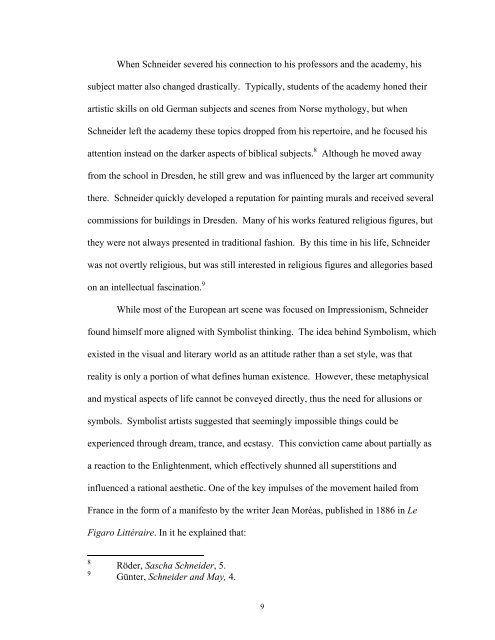the life and works of sascha schneider - ETD - Louisiana State ...
the life and works of sascha schneider - ETD - Louisiana State ...
the life and works of sascha schneider - ETD - Louisiana State ...
Create successful ePaper yourself
Turn your PDF publications into a flip-book with our unique Google optimized e-Paper software.
When Schneider severed his connection to his pr<strong>of</strong>essors <strong>and</strong> <strong>the</strong> academy, his<br />
subject matter also changed drastically. Typically, students <strong>of</strong> <strong>the</strong> academy honed <strong>the</strong>ir<br />
artistic skills on old German subjects <strong>and</strong> scenes from Norse mythology, but when<br />
Schneider left <strong>the</strong> academy <strong>the</strong>se topics dropped from his repertoire, <strong>and</strong> he focused his<br />
attention instead on <strong>the</strong> darker aspects <strong>of</strong> biblical subjects. 8<br />
Although he moved away<br />
from <strong>the</strong> school in Dresden, he still grew <strong>and</strong> was influenced by <strong>the</strong> larger art community<br />
<strong>the</strong>re. Schneider quickly developed a reputation for painting murals <strong>and</strong> received several<br />
commissions for buildings in Dresden. Many <strong>of</strong> his <strong>works</strong> featured religious figures, but<br />
<strong>the</strong>y were not always presented in traditional fashion. By this time in his <strong>life</strong>, Schneider<br />
was not overtly religious, but was still interested in religious figures <strong>and</strong> allegories based<br />
on an intellectual fascination. 9<br />
While most <strong>of</strong> <strong>the</strong> European art scene was focused on Impressionism, Schneider<br />
found himself more aligned with Symbolist thinking. The idea behind Symbolism, which<br />
existed in <strong>the</strong> visual <strong>and</strong> literary world as an attitude ra<strong>the</strong>r than a set style, was that<br />
reality is only a portion <strong>of</strong> what defines human existence. However, <strong>the</strong>se metaphysical<br />
<strong>and</strong> mystical aspects <strong>of</strong> <strong>life</strong> cannot be conveyed directly, thus <strong>the</strong> need for allusions or<br />
symbols. Symbolist artists suggested that seemingly impossible things could be<br />
experienced through dream, trance, <strong>and</strong> ecstasy. This conviction came about partially as<br />
a reaction to <strong>the</strong> Enlightenment, which effectively shunned all superstitions <strong>and</strong><br />
influenced a rational aes<strong>the</strong>tic. One <strong>of</strong> <strong>the</strong> key impulses <strong>of</strong> <strong>the</strong> movement hailed from<br />
France in <strong>the</strong> form <strong>of</strong> a manifesto by <strong>the</strong> writer Jean Moréas, published in 1886 in Le<br />
Figaro Littèraire. In it he explained that:<br />
8<br />
9<br />
Röder, Sascha Schneider, 5.<br />
Günter, Schneider <strong>and</strong> May, 4.<br />
9
















